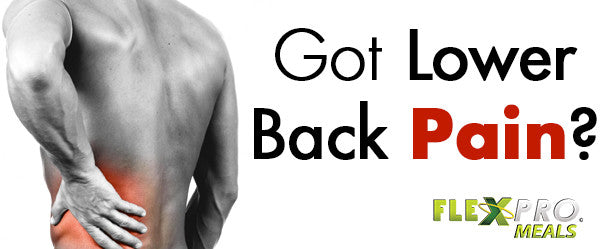
Got Lower Back Pain?

Are Your Workouts Causing Lower Back Pain?
If you’ve been working out for a long time, chances are you’ve had lower back issues at one point or another. Don’t feel bad; 4 out of 5 people are affected by lower back pain-- it’s just the nature of the workout beast. All of the strenuous activity you put your body through during a workout can sometimes take a toll on your lower back, especially because no matter what you do, your lower back is always involved.
Often times this lower back pain is due to a herniated disc, meaning, the cartilage in between your spine’s vertebrae has become inflamed. This will result in a sharp pain shooting from your lower back to your butt, and even sometimes as far as your legs. If the pain is too severe, don’t hesitate to go see a doctor, but most of the time the pain will decrease gradually by taking the right steps to help it heal.
Causes
Aging: As we get older the water retention in our spinal discs decreases, leaving your back less flexible and more susceptible to injury.
Previous Injury: If you’ve had a back injury in your past, your back is more prone to pain and new injuries.
Lifting Too Heavy: Lifting heavy weight is good for both men and women to incorporate into their weight training, but lifting more weight than your body can handle at the time can land you on the couch for a few weeks.
Bad Form: Bad form and lifting too heavy often go hand-in-hand when it comes to workout injuries. Exercises like deadlifts and squats often leave even the most seasoned weight lifters in pain.
Normal Wear & Tear: If you are a beast in the gym, you may be doing something that’s a part of your normal workout routine when you throw your back out. This may not be a result of doing something wrong, but rather due to the normal wear and tear you put on your body when working out religiously.
Poor Posture: If you have a desk job, most likely you spend most of the day assuming the slouched position. This can put unnecessary pressure on your back and lead to pain.
Prevention
Once you have allowed your back to thoroughly heal, there are actions you can take to help prevent lower back problems in the future.
Know Your Body: If you have chronic lower back pain and you notice that you’re starting to get the start of that tingling sensation in your back, stop what you’re doing and take it easy for a few days.
Improve Your Form: If you are new to lifting, utilize a personal trainer. Trainers will not only teach you the right form right out of the gate, but they’ll also correct your form as you go.
If a trainer is too expensive, try an at-home workout program like P90X or Body Beast that will demonstrate the correct form. Then workout in front of a mirror so you can make sure you are doing each exercise correctly.
Don’t Let Your Ego Get in the Way: Ego is a good thing to have in the gym to a certain extent, but don’t let it cause you to lift more weight than you can handle. Not only can this cause injury, it can also lead to you looking like a goofball falling in them middle of the gym floor crying out in pain.
Stretch: Stretching after each workout can go a long way in the recovery and injury prevention process. Even better, try doing a stretch, yoga, or Pilates routine on your rest days to keep your spine healthy and flexible, leaving it less prone to injury.
Improve your Posture: Weight training as a whole is a great way to naturally improve your posture, but if you have a desk job, try to be more conscious of your posture while sitting to avoid unnecessary back pain.
Back Support: If lower back pain is a repeating issue for you, try wearing a lifting belt or back brace belt when you know you are going to do some heavy lifting or any other activity that causes your back pain to flair up.
Nurse Your Pain:
REST!: No matter how much it may suck, rest is the number one component in getting your back…back in the game. Resist the temptation to hit the gym for a week or two. For some this is like asking he impossible, but would you rather miss a week of workouts our cause a more serious injury to your back?
Heat: Place a heating pad on your back while you are sitting at work or watching TV in the evening. Taking a warm bath or shower can also alleviate some pain. Using muscle rubs and patches like those made by Icy Hot is also a good way to get some pain relief.
Cold: If you are experiencing back spasms, apply cold compress or ice to your back for no more than 20 minutes at a time a multiple times a day.
Medication: Try popping a few over the counter anti-inflammatory pills to get some relief. If the pain is bad enough, visit your doctor and have them prescribe a muscle relaxer to help relieve the pain.
Share
